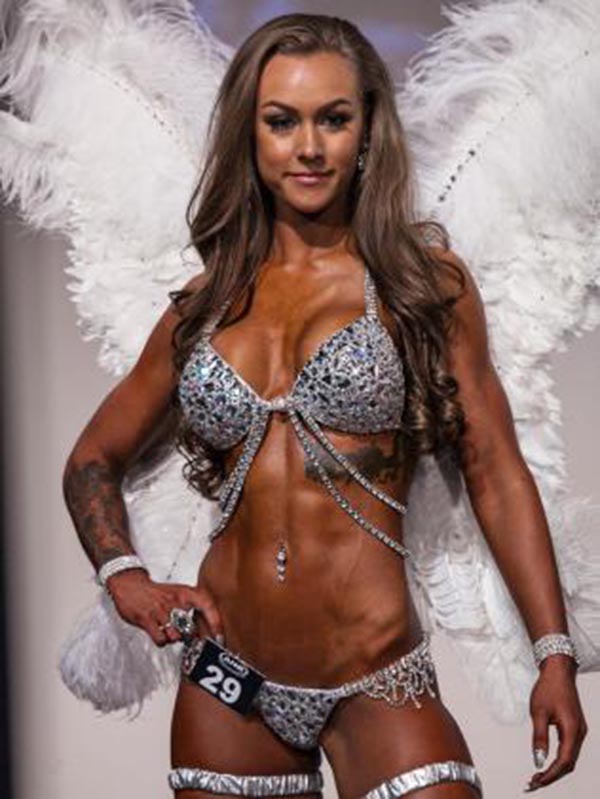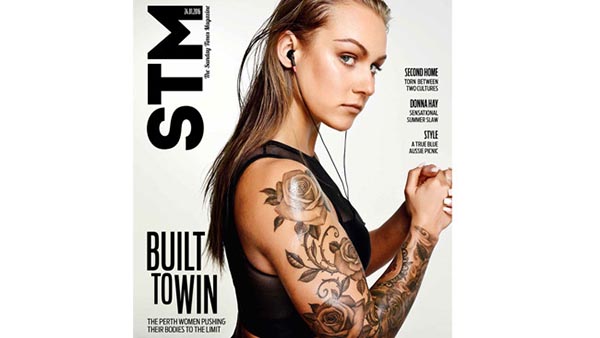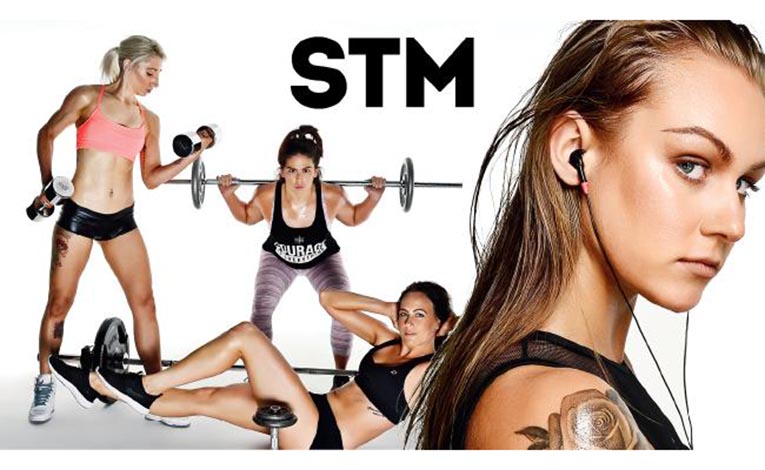It’s a Saturday afternoon in Spring and I’m standing in a Balcatta function hall watching a muscular woman in a diamante bikini down a shot of vodka.
She’s more than just toned — she’s Wonder Woman.
And if we were anywhere else, this Amazonian goddess would draw a stare. But, surrounded by more than 40 other half-naked beefcake girls, she’s just another face in the crowd.
It’s me, dressed in jeans and with a decidedly un-extraordinary figure, who stands out like a sore thumb.
We’re backstage at the National Amateur Body-Builders Association WA 2015 contest and the women are competitors preparing to go onstage.
Some are applying lip gloss and making final touches to their spray tans.
Others are sipping glasses of wine or doing frantic last-minute crunches.
To my right, a blonde, who looks like she could knock me to the ground with one finger, says she needs to sit down because she feels dizzy.
Most of the girls, however, are eating. Not protein bars or kale shakes, but lollies, muffins, chocolates and even hot chips covered in tomato sauce.
After months of preparation and strict dieting — with some competitors cutting carbs completely and exercising up to five hours a day — the idea is the sudden introduction of salt and sugar will “bloat” their muscles to make them look bigger.
Most competitors also stop drinking fluids from the night before.
On the day of competition they drink alcohol because, as a dehydrant, it will further improve their “vascularity” and make their veins “pop” to appear more dramatic.
While female bodybuilders used to be a rarity, young women are now outnumbering men at competitions like these.
There are 19 men here compared with 42 women.
In other WA competitions, such as the International Federation of Bodybuilding contest, the number of women competitors are nearly triple that of the men.
Waif icons of the past, such as Kate Moss, are outdated.
Social media has propelled bodybuilding into the mainstream, and with the top competitors amassing tens of thousands of young followers on Facebook and Instagram, the muscular figure is quickly becoming upheld as the “ideal” body type.
Some of the bodybuilders work within the fitness industry, but most are ordinary young women — hairdressers, university students and primary school teachers — who see pushing their body to the limits as the new sexy. The youngest is just 17.

DETERMINATION AND DEHYDRATION
Sasha Heber, 20, has been going to the gym since she was 15. She has transformed herself from a slender-framed 52kg to a muscly 72kg.
While she has been told by family members that her muscles make her “look like a man”, she feels her bulging body represents willpower and determination.
Heber competes in the “fitness” category of competitions. To prepare herself for a show, she’ll spend 20 weeks exercising for four hours a day.
The week before the competition she cuts carbs out of her diet and starts water-loading — eventually she’ll be drinking seven litres of water a day.
This is a common practice among competitors and many girls will consume as many as 10 litres a day.
The idea is the excess water will “flush the salt out of the body” and make the muscles look more pronounced.
From the night before the show, Heber starts to dehydrate.
She takes a diuretic — a medication that promotes the production of urine and is normally used by elderly people — to “dry herself” further.
She won’t drink properly again until she steps off the stage.
“It just dries you up so you get rid of all your water, so that when you’re onstage you’re really dry and dehydrated so the water sticks to your muscles,” Heber says.
The process is exhausting and it’s common to hear stories of women fainting prior to the competition.
“You put your body through so much stress,” Heber says. “Just to put my shoe on at the end was an absolute mission.”

For her, it’s not just about becoming “bigger” but creating what girls call a “designer body” — moulding her figure so she has better definition, a tiny waist and bigger legs.
The fact she needs to push herself to the extreme to achieve her goal seems to be part of the appeal.
“You do get quite skinny. You get gaunt in your face. I probably had bags under my eyes and towards the end I wasn’t sleeping very well,” she says.
“I wasn’t getting many carbs and I was finding it hard to sleep through the night. You’re drinking so much water you’re probably getting up three times a night to pee.”
Tamara Legge, 23, tells me she believes the extreme aspect of bodybuilding is what makes it a sport, not a fad.
Last year Legge had surgery to remove pre-cancerous cells on her uterus. After the operation she had three weeks of bleeding.
Two days after the bleeding stopped she was back in the gym. And 10 weeks later she was stepping on stage to compete in the figure category in IFBB October contest.
She says she was prepared to drop out if she felt her life was at risk, but admits getting herself into shape took drastic measures.
As the competition grew close, she was exercising three hours a day, while dropping her calorie intake to under 1000.
She was simply “too fat”, she says.
“That was when things got really nasty trying to just cut it back — more training, really undereating,” Legge says. “I just couldn’t pull out of this comp. I felt like if I didn’t do this comp I may as well never have done one. I just had to do it.”
I’m lucky. I haven’t had stupid coaches that have said ‘Yeah let’s stick you on this’ or ‘You can smoke a crack pipe a couple of weeks before your comp to lose weight’.” – Tamara Legge
Legge and Heber are both “natural” competitors. This means that while they might use supplements in their preparation, they do not take prescription medications or illegal steroids. But both say the use of drugs — specifically estrogen blockers — is “common” in the industry. How common is common?
“Massive, massive,” Legge says. “I know some coaches are very big on suggesting stuff like that, especially to new girls in the industry.
“I’m lucky. I haven’t had stupid coaches that have said ‘Yeah let’s stick you on this’ or ‘You can smoke a crack pipe a couple of weeks before your comp to lose weight’.”
Only two of the five key Australian bodybuilding organisations do drug testing. Most competitions do not openly discourage drug use.

And with Australian Facebook groups dedicated to buying and selling steroids, they appear all too easy to obtain.
Facebook users who claim to be selling drugs answer questions openly online.
They say they have as many female customers as males and tell me I can purchase a 10-week package of Clomid (an estrogen modifier) and Testoxyl Cypionate (a steroid) for $148.
This will be “discretely (sic) packaged as food stuffs” and will come complete with 22 needles.
National Amateur Body-Builders’ Association WA promoter Adam Baker — whose daughter Karlie competes in bodybuilding competitions — says they do not drug-test because it is “too expensive”.
“We rely on sponsorship to run our shows. If you’re doing testing (of) two or three athletes at $1000 a pop, it’s going to cost you a fortune,” he says.
“It’s a bit of a grey area … We don’t discourage it. It’s one of those things where people don’t really talk about it.”
But Baker believes steroid use is more common among men than women.
“I can tell you for a fact 90 per cent or maybe higher (of women) are all naturals,” he says. “They live a very strict lifestyle, (so) of course they are going to look bigger and better than everyone else. Their lifestyle is totally geared around what they eat and their training.”
He says that the increased popularity of female competitors is linked with the introduction of the bikini competition — an entry-level category that allows a more “achievable” look.
PUSHING BODIES TO THE EXTREMEM
A bodybuilder himself, Baker sees the trend as “health orientated” and thinks it is possible for competitors to lead balanced lifestyles.
But Australian Medical Association WA spokesman David Mountain, head of emergency at Sir Charles Gairdner Hospital, is concerned bodybuilding is becoming an unhealthy “glorification of extremes”.
He says female competitors drinking 10 litres of fluids a day are running the risk of damaging their internal organs.
“These are all basically (methods of) pushing bodies to extremes to look a particular way. It’s never really a good thing to be aiming for,” Dr Mountain says.
“It drives more dysfunctional behaviour, more problems with body image and I think it’s problematic that we have a whole branch of pseudo-sport that is completely about image and distorted body shape.”
Mountain blames social media for “normalising” unhealthy behaviours.
“Once this subculture is there, it’s very hard to put the brakes on,” he says.
“There are people who end up with serious problems — kidney problems, liver disease, and it’s not good for fertility. There are a whole bunch of long-term side effects. Just because it’s on social media doesn’t make it normal. It might be normalised, but that’s the problem.”
It’s a bit of a slippery slope, once you get caught up in the culture and find yourself doing these things,” – Dr Sue Byrne
University of WA School of Psychology associate professor Sue Byrne, who specialises in the treatment of eating disorders, says overexercising issues are becoming more common in young women.
“The ideal look is changing from the emasculated, Twiggy look, to a fit, muscular body type,” Dr Byrne says.
She says people who obsessively exercise — one of the common traits of eating disorders — will continue to exercise even if they are really sick or injured.
“And if they can’t exercise for any reason they will feel very guilty and upset,” she says.
Byrne says bodybuilding is fraught with risks for women who have had a history of disordered eating. And social media, she believes, is encouraging a dangerous culture of comparison.
“It’s a bit of a slippery slope, once you get caught up in the culture and find yourself doing these things,” she says.
“You need to look at the bigger picture and think maybe something that started out about trying to keep fit and healthy has now become extremely obsessive.”

Personal trainer Emilie Bric, however, disagrees. She credits bodybuilding with helping her overcome her nine-year struggle with anorexia.
She started competing four years ago.
Now 28, she says that the strict lifestyle initially added fuel to her body image issues, but training eventually helped her lose her fear of eating.
“Coming from being anorexic, it’s very tricky … You can get addicted to dieting. That’s what I struggled with at the start,” Bric says.
“But you realise you can actually 100 per cent control food and you’re not scared of it anymore. That’s what happens when you’re anorexic, because food is basically your enemy. Now it’s changed that food is a tool to get to me to where I want to be”.
Bric is not the only competitor who says bodybuilding has given her a sense of purpose. Most of the girls have a religious-like reverence for the gym.
Fellow competitors are described as their “sisters” and “fit-family”. And they swap motivational quotes, which have become popular “fitspo memes” on social media, like it is gospel.
One girl proudly shows off her T-shirt saying “Find your limit, then crush it”. Another has “Unless you puke, faint or die, keep going” as the screensaver on her phone.
Cassandra Page, 30, entered her first competition nearly three years ago. Her mother had recently passed away and she was struggling with depression. One day she saw a picture of muscular women in a bikini on Facebook and had what she describes as a “complete life turnaround”. “I was eating McDonald’s, never going to the gym. But I saw this photo and thought, ‘I want to look like that’,” Page says.
After coming second in the NABBA over-30 fitness category, she wants to become bigger and move up to the more competitive “figure” level.
“Basically I’ll have to start training like a man,” says Page, who works in the make-up industry. “I love it, though. I think I’ll do it for the rest of my life.”

‘POST-COMP DEPRESSION’
Karlie Baker, 28, says becoming involved in the industry “transformed” her from a “party girl” to a gym “addict”.
“Before I felt like I was wandering aimlessly. I had no goals. I was just unhealthy,” says Baker, who now works at a gym.
“At the start … I was thinking it was just one of those little phases I was going through. But now I love the preparation of it, pushing myself, seeing how my body could look.”
But with their lives revolving around competition, many say they experience what is dubbed “post-comp depression” once the season is finished and they start gaining weight.
Bric says she struggles with feeling purposeless after competitions.
Gaining weight again can be upsetting, especially when she sees images of other people looking “better than her” on social media.
“It’s hard if you don’t have a goal or another competition to train for,” she says.
“You have to go back to eating normally and it starts to be a lot of things in your head. It can get too much and you start to feel really depressed.
“It does go away, but it is a thing a lot of people struggle with.”
Driving away from the bodybuilding competition, I’m aware of the number of gyms I pass. On one strip there are seven within metres of each other. I start to count the number of fast-food restaurants.
The pattern is gym-McDonald’s-gym-McDonald’s. I arrive home and have counted more than 20 gyms, and more than 20 takeaway joints. We are a culture of polar extremes.
Weeks later when I meet Tamara Legge again, I ask her what she says to people who believe bodybuilding is unhealthy. She tells me that there is a famous female bodybuilder who has the motto “no balance”.
“Whenever you go to an extreme level at anything in life it’s going to get unhealthy. You can’t be a pro level without having injuries and setbacks,” she says.
“Swimmers get shoulder injuries, football players get ACL knees, gymnastic girls don’t get their periods. Yet they don’t frown upon that as much.
“If you want to get to the top of pretty much any sport, there’s going to be a boundary you step over or everyone would do it.”
Courtesy of: Perth Now
Cover photo: Richard Hatherly

Comments are closed.